Design Tasmania
Corner of Brisbane and Tamar streets
Launceston, 7250
Tasmania
info@designtasmania.com.au
+61 3 6331 5506

Heartwood: Tasmanian Women in Timber
25 October 2025 - 8 February 2026
Timber is deeply embedded in Tasmania’s design story, and women have long shaped how it is used, valued, and reimagined. From the refined Arts and Crafts-era carvings of Ellen Nora (Nellie) Payne - work that helped establish Tasmanian women’s reputation for woodworking excellence - to today’s contemporary designers experimenting with salvaged materials or pushing timber into engineered precision, women have built a lineage of innovation grounded in place.
At the centre of Heartwood is a new acquisitive commission by furniture designer-maker Laura McCusker. Forest Stand joins the Design Tasmania Wood Collection, strengthening the representation of women within this nationally significant archive, and recognising Laura as one of Tasmania’s most celebrated contemporary designers. The commission marks the 10th year of Design Tasmania’s leading Women in Design program, conceived to celebrate and progress the work of women in the Australian design industry.
Alongside McCusker’s work in the exhibition are now-iconic pieces by Tasmanian designers Sally Brown, Pippa Dickson, Linda Van Niekerk, Linda Fredheim, Gay Hawkes and Ellen Nora Payne, drawn from Design Tamsania's existing Wood Collection, and with loans from other private and public collections across the State. Each shows a unique relationship with Tasmanian timber – ideas, values and philosophies are explored through carving, charring, bending, shaping and finishing.
Heartwood is a tribute to the women whose skill, persistence and imagination have carried timber craft forward in Tasmania - forming an unbroken, living lineage of design and making.
Laura McCusker
Laura McCusker (b. 1975 Sydney)has been designing and making furniture for over 25 years, creating functional pieces from honest materials.
After founding her business in Sydney, she settled in Tasmania, working from a 110-year-old former apple-packing shed beside the New Town Rivulet. Inspired by her adopted island’s natural beauty and quiet simplicity, she makes work that is sympathetic to its surroundings, letting the timber speak for itself.
With a deep respect for materials, she favours the five species known collectively as Tasmanian Oak, crafting them into bespoke furniture, custom joinery, and functional art. Her work features at Mona, the Tasmanian Museum and Art Gallery, Spring Bay Mill, and in private domestic settings nationally.
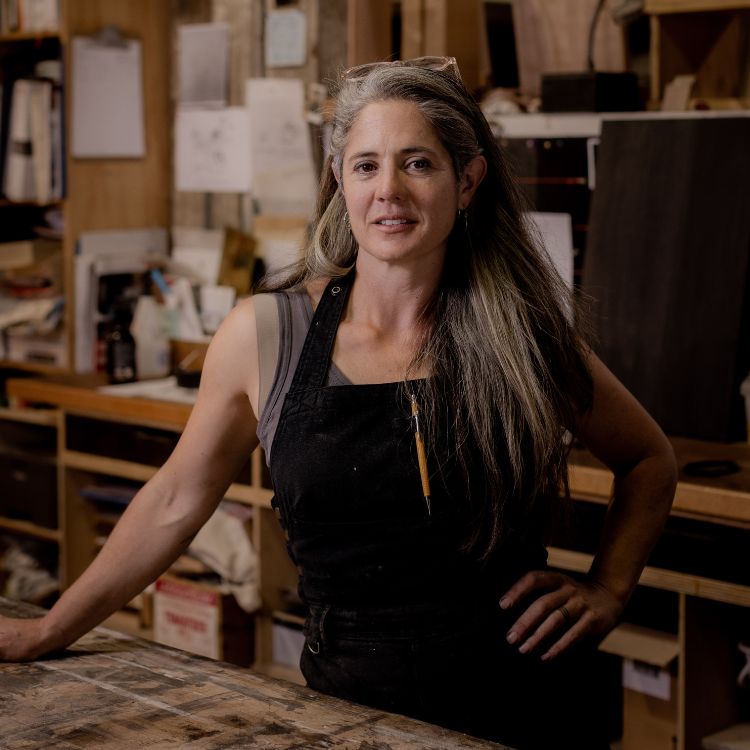
Photo credit: Rosie Hastie
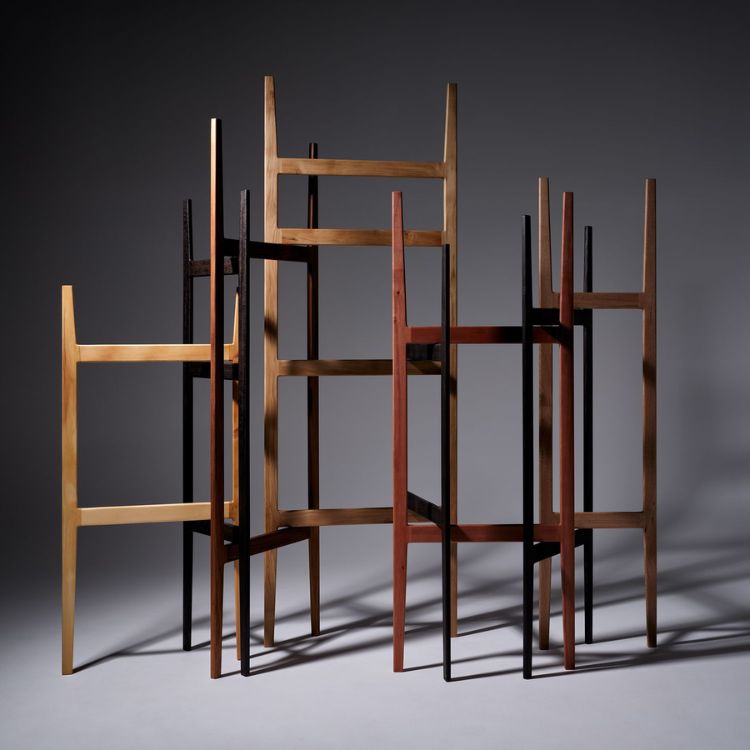
Photo by Peter Whyte
Forest Stand
At first glance, Forest Stand appears simple, but its joinery is deceptively complex, revealing precision and craft. Made in Tasmanian oak, Huon pine, sassafras, Tasmanian blackwood and myrtle, this pared-back yet bespoke clothes stand balances strength with lightness of form. Contrasting finishes - oxidised and natural - emphasise its silhouette and negative space, intensifying the play of light and shadow. Functional yet sculptural, it is both beautiful and useful, a utilitarian domestic object exemplifying Laura’s aesthetic and philosophy.
Forest Stand is a commissioned piece and joins the Design Tasmania Wood Collection.
2025
Tasmanian oak, Huon pine, Sassafras, Tasmanian blackwood and Tasmanian myrtle
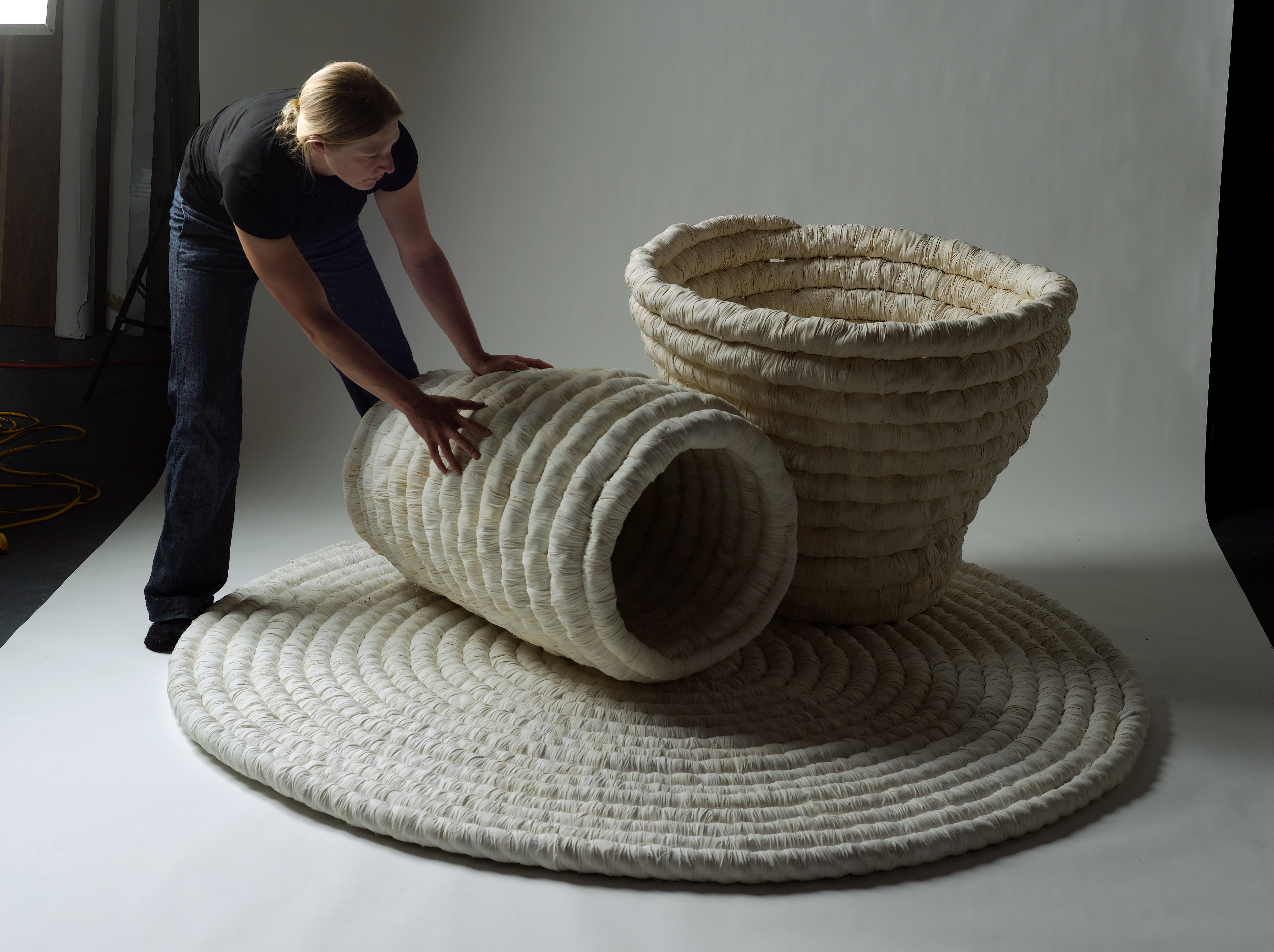
Photo by Peter Whyte
Sally Brown
Sally Brown (b 1982 Tasmania) trained at the University of Tasmania in Furniture Design.
As an artist and designer her practicer has included making unique unique furniture, sculptural, and functional objects, often reworking salvaged materials. Sally’s fascination with natural forms and structures she observes in her surrounding environment has always informed the aesthetic of her artistic practice. This influence emerges in the use of organic forms, natural colours and an emphasis on pattern and texture evident in her work. Sally's work is all made by hand, and this hands-on, crafting process has always been very important to her. The not-quite-perfect character of a handcrafted object provides for Sally a form of artistic expression, as do the subtle differences and variations that render each piece unique.
Sally no longer practices furniture-making, however her legacy lives on through work held in major collections including the Tasmanian Museum and Art Gallery, the Museum of Old and New Art (MONA), Clarence Art Collection and Design Tasmania Wood Collection.
Reflecting on her early work shown in Heartwood, Sally says:
"I am surprised and pleased to look at these pieces and find they have a kind of timelessness. Even so many years on, they would sit well in any contemporary setting. Seeing these pieces through the distance of time creates the curious feeling that they were made by a different person, which, in a way, they were. Much stronger is my connection with the process, the memory of drawing, making, experimenting; of things in bits in the workshop."
Char Stools (3)
These three stools were made individually by hand, with deliberate, subtle differences. Each piece of Eucalypt was roughly cut to shape, then placed on a fire and carefully turned so that the action of the flames smoothed each piece to shape and hardened the timber. Once cooled, the loose charcoal was removed by wire brushing. The leg structure is made from stainless steel bar and differs from stool to stool.
Salvaged eucalypt, Stainless steel, beeswax
450mm (h) x 400mm (w) x 400mm (d)
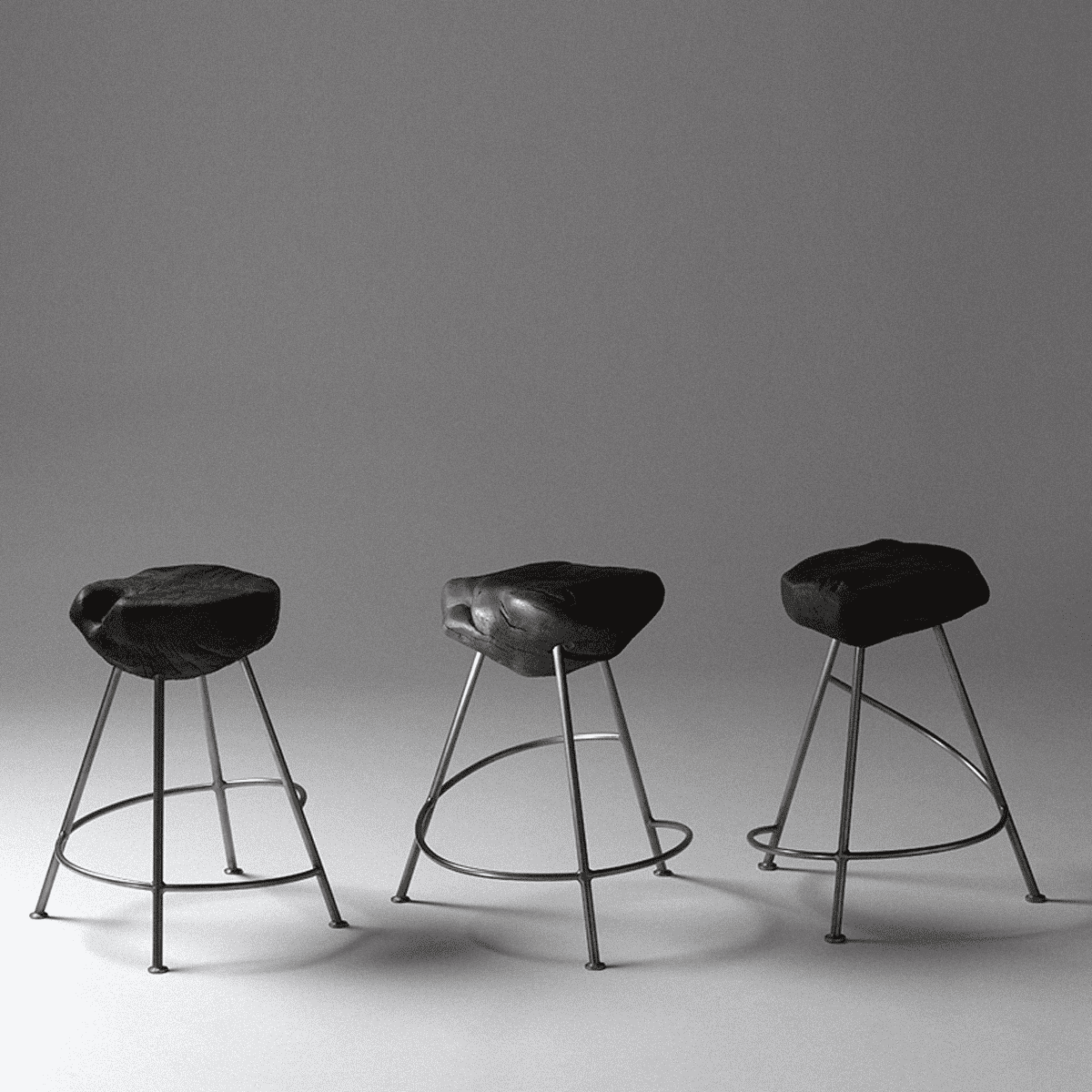
Photo by Peter Whyte
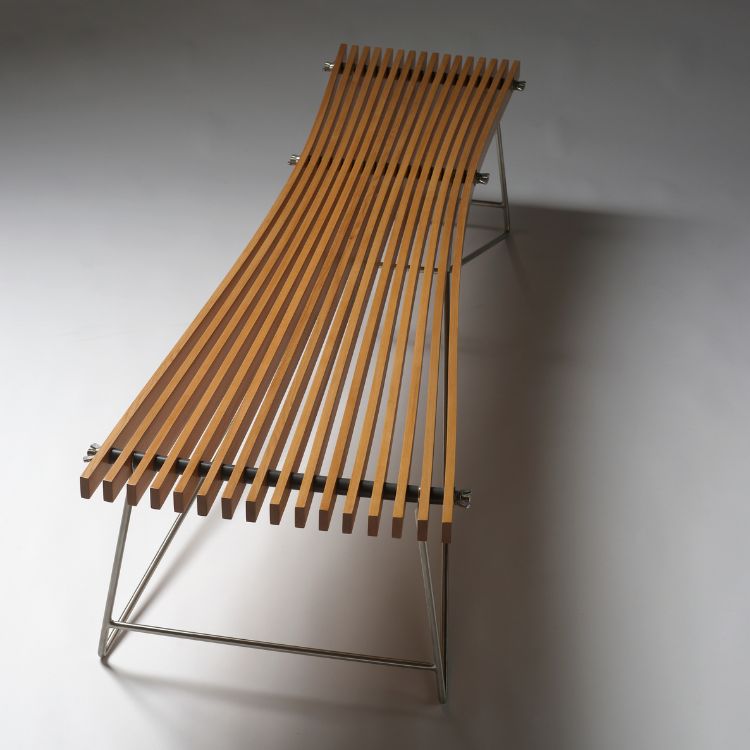
Photo by Peter Whyte
Warp Bench
This piece emerged from the consideration of slats for a bench seat being much stronger
on edge than flat, and from celery top pine being suitable for bending into curves, as in boatbuilding. The form of Warp Bench is partly inspired by the accumulative tension that sometimes occurs in a piece of weaving, causing the warp strands to become more tightly pinched toward the middle. The blonde colour of the wood and the splayed curves are to me evocative of water runnels across a beach, or the strand–like tension within a tree trunk.
Warp Bench won the acquisitive Clarence Prize for Furniture in 2007 and has been loaned by City of Clarence at Rosny Barn.
Celery top pine, Stainless steel, PVC
400mm (h) x 1750mm (w) x 600mm (d)
Pippa Dickson
Pippa Dickson grew up in Western Australia and, after studying arts and Asian studies and spending time in Indonesia, trained as a furniture designer, completing a PhD at the University of Tasmania in 2007. Her work was exhibited nationally and is held in the collections of the Henry Jones Art Hotel and the Museum of Old and New Art.
She then moved into arts and cultural management, where for over 20 years she has been a strong advocate for artists and designers through senior leadership roles. With a passion for start-up initiatives, transformational projects and community engagement, she has contributed to major cultural programs, boards and philanthropic ventures, including serving as Chair of Design Tasmania and helping to initiate Women in Design.
While her professional focus has been on supporting others, she is now revisiting unrealised ideas from her early design practice. Based in Sydney but calling Tasmania home, she continues to shape the arts and cultural landscape internationally through creative projects, advocacy and leadership.
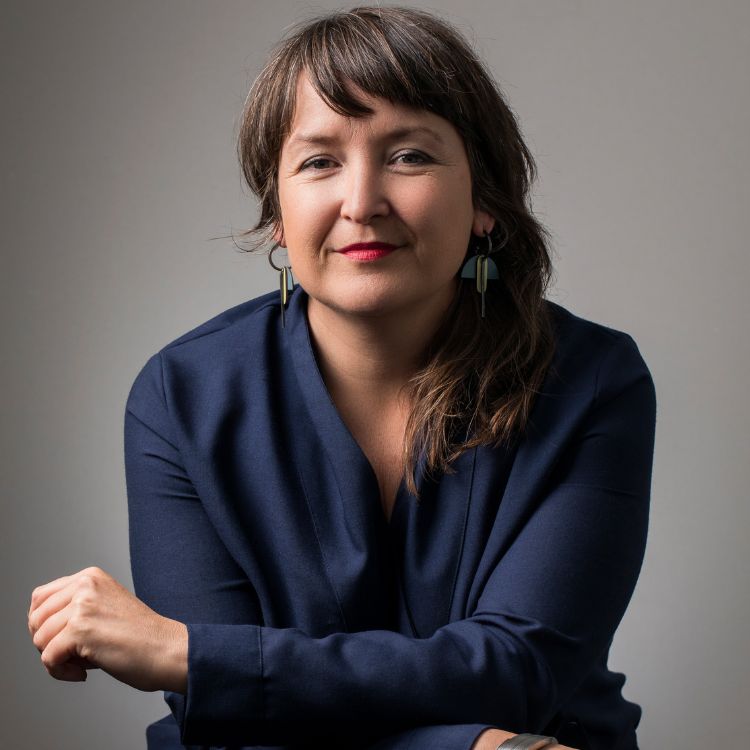
Photo by Remi Chauvin
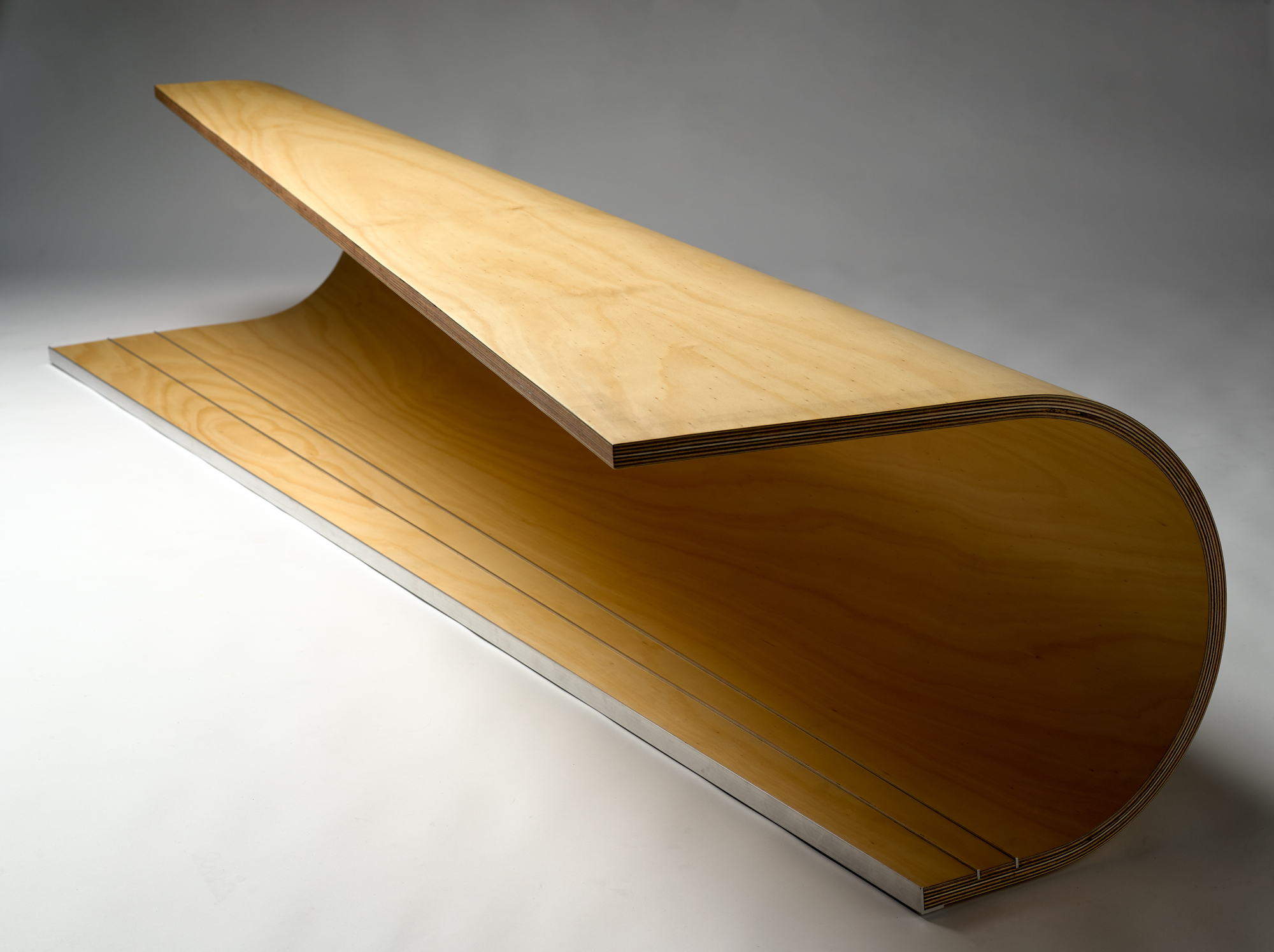
Photo by Peter Whyte
Variable Coupling
This bench seat was designed in response to the linear aesthetics of architectural spaces common to large public transit areas. Pippa aimed to capture the poetics of flight and the tensions of stasis and dynamism inherent in liminal space through the ‘x’ in plan view (representing the propeller frozen in mid rotation) and the open ‘c’ form cantilever in profile (symbolising weightlessness). Derived from the idea of a simple paper plane, a folded piece of paper was reduced to a soft and regular curve capturing momentary stillness and the expectation of movement.
"With Variable Coupling I aimed for visual simplicity and strength. The dimensions of the plywood sheet suited the scale and the 210 mm radius. The minimal patterning of Araucaria cunninghamii (Hoop Pine) gave it a sense of ‘coolness’ and industrial anonymity, detaching it from place and evoking the non-place of liminal areas I was exploring at the time. The laminated plywood allowed the unsupported curved form and delivered the uncomplicated aesthetic I was seeking." — Pippa Dickson
Variable Coupling is part of Design Tasmania’s Wood Collection on permanent display at Design Tasmania.
Hoop pine, lacquer, aluminium
430mm(h) x 2450mm(w) x 600mm(d)
Made by Pippa Dickson and David Roberts
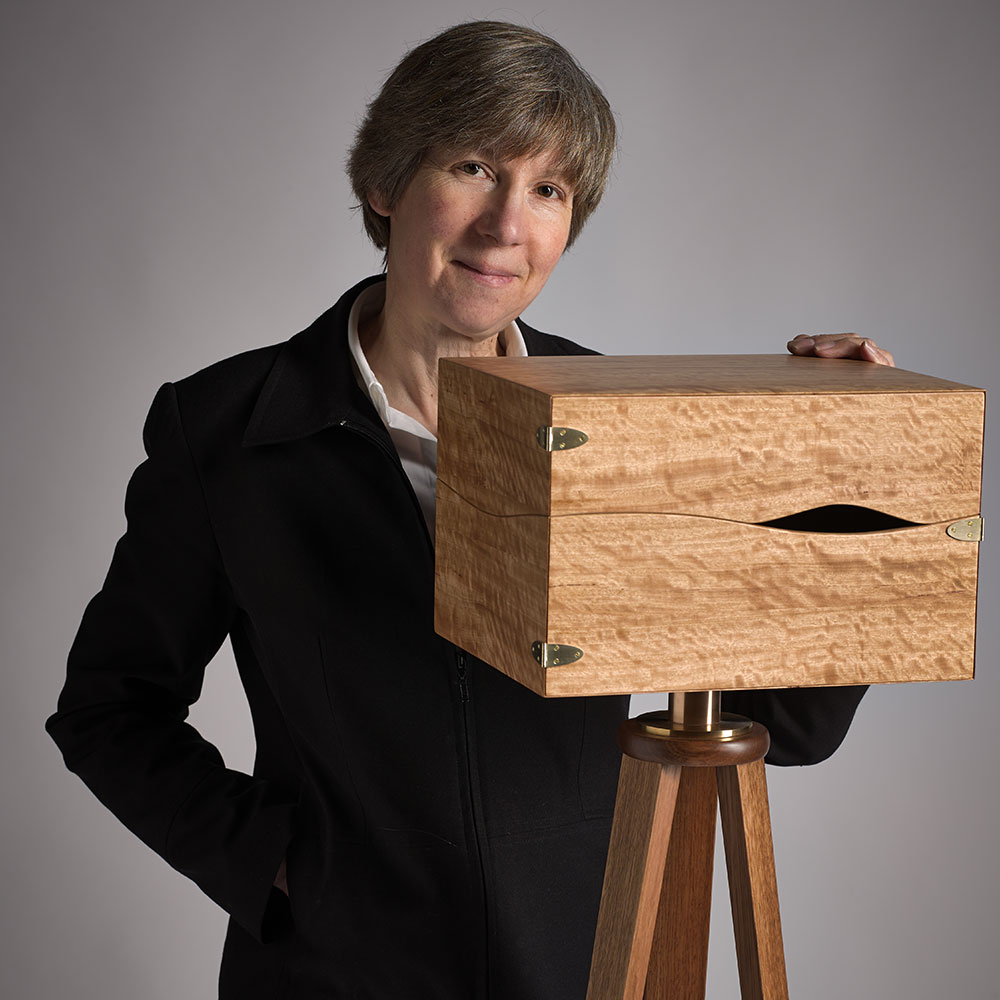
Photo by Peter Whyte
Linda Fredheim
Linda (b. 1960) is a furniture designer and maker based in nipaluna/Hobart. She completed a BFA (Design in Wood) at the University of Tasmania’s School of Art in 1992 and now runs a part-time design practice from a studio with partner Stuart Houghton.
As a studio-based designer working primarily with timber, Linda’s practice includes commissions, limited production pieces, and collaborations with other artists and designers. Her work has been exhibited widely in Australia and internationally, and she has taught at both the UTAS School of Art and Sturt School for Wood in Mittagong, NSW.
Through membership in several design organisations, she remains committed to supporting the growth of the craft and design sector.
More of Linda's work can be found at www.lindafredheim.com.au
“I seek to design and make objects that have a quiet presence, objects that don’t demand attention but invite interaction through the exploration of the details of the piece.”
Myrtle Cabinets
The pair of cabinets reflect Linda’s interest in surface decoration and the process of labelling, cataloguing, and storage. The motifs on the label and inside each drawer represent the real or imaginary imprint left by an object. The cabinets are small personal pieces of furniture, identical in shape, but different in their detailing. They are designed to be together but almost have their own separate personalities. Like many of Linda’s other cabinets, the attention to detailing means the viewer has to interact with and use the piece to fully appreciate it.
“The Myrtle Cabinets were designed and made after having worked with painter John Wolseley to produce some furniture and sculptural pieces to display his drawings and paintings for the exhibition Patagonia to Tasmania: Origin Movement Species – Tracing the Southern Continents. Working for and with other artists has and continues to be interesting and rewarding as it helps me see my work from a different perspective and makes me try things I might not have otherwise considered, with the unexplored ideas often resurfacing in my own pieces. This was the first time I used engraving on both the drawer fronts and bottoms of a piece — something I continued to refine and use in subsequent work, including my Order Under Canvas collection.”
Myrtle, Hoop pine plywood, MDF, bronze, copper
650mm (h) x 400mm (w) x 400mm (d)
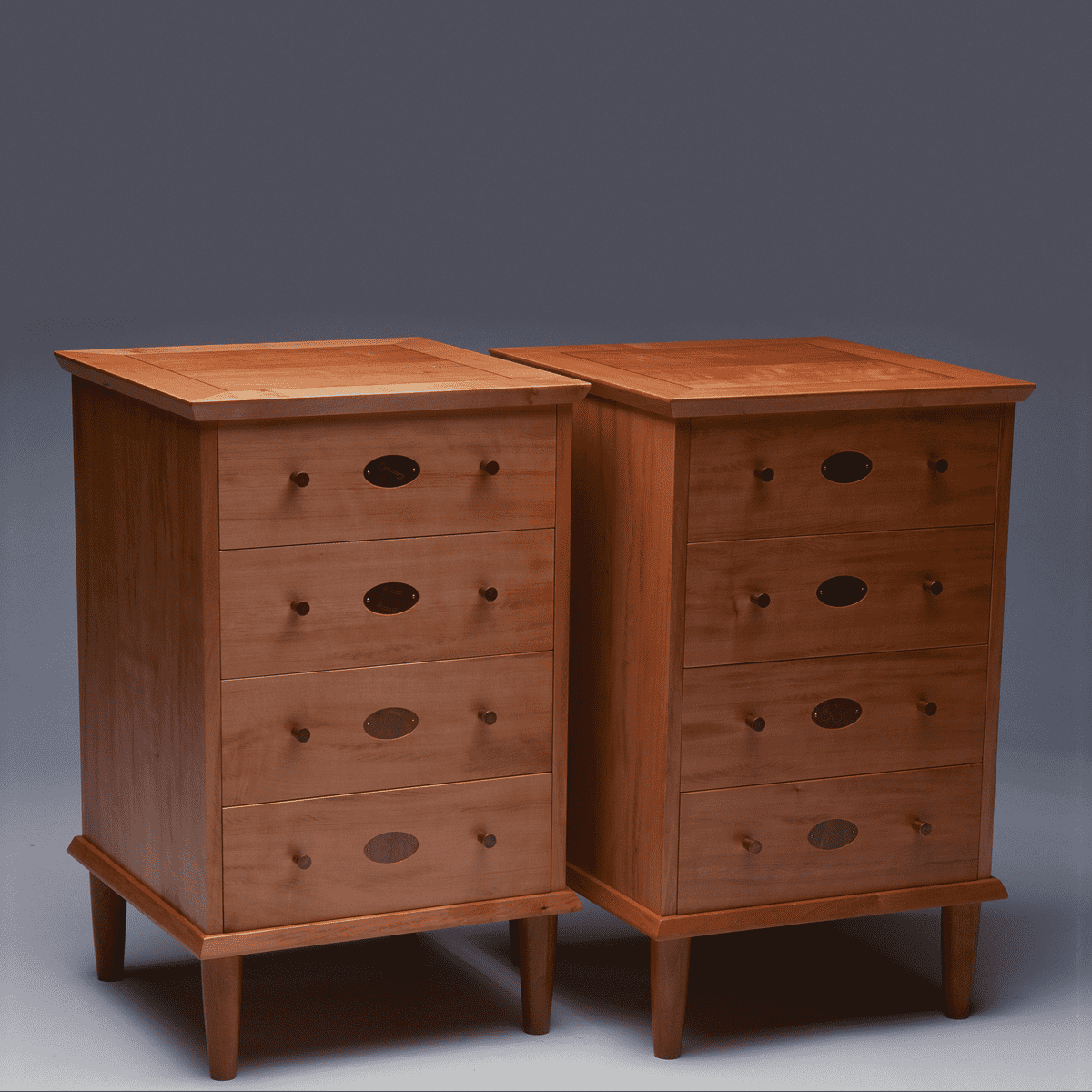
Photo by Peter Whyte
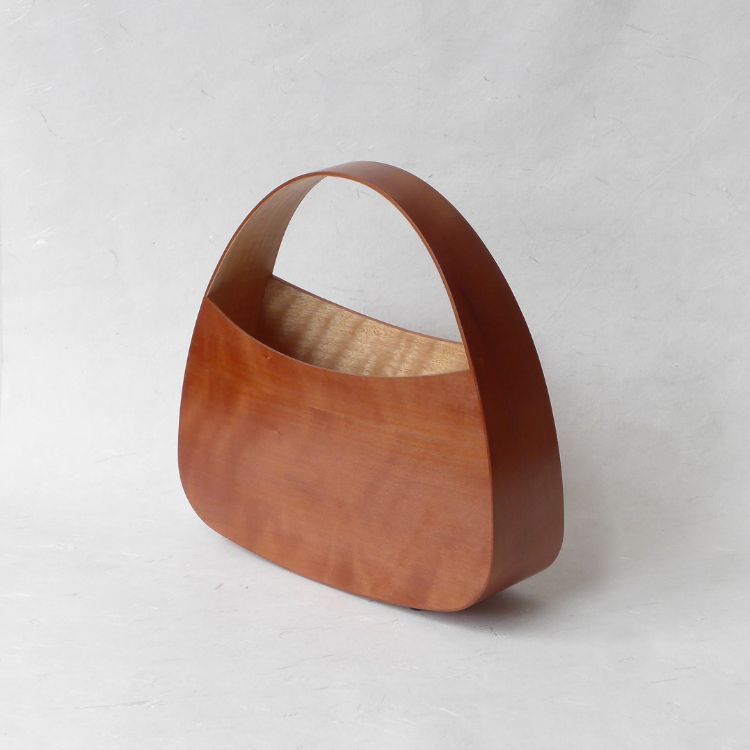
Photo by Linda Fredheim
Kurv 2.1
Linda began making timber handbags for a project celebrating the 100-year anniversary of the Bauhaus. Drawing on form and colour exercises undertaken by students, the handbags became small studies in form and function - objects to experiment with in spare hours using mostly scraps and leftovers from other projects.
This piece reworks a 2021 design with new side panels, a fuller curve, and improved proportions. Linda is fascinated by campaign furniture for the sense of style and order it brought to its owners’ temporary lodgings, and considers the timber bags a distillation of that ethos - objects both practical and impractical at once.
Tasmanian myrtle and Eucalypt veneer
240mm (h) x 240mm (w) x 83mm (d)
Tea Caddy for Amy Sherwin
This caddy is part of a series of five, each inspired by a notable person associated with Hadley's Orient Hotel in Hobart. Opera singer Amy Sherwin (Tasmania's nightingale) grew up in the Huon Valley, and it is reported that as a child, she would linger and sing near the road that ran past her family's farm, in the hope she might be discovered.
Linda chose Leatherwood for her caddy, a beautifully grained tough timber that grows in that vicinity, and decorated the lid of the box with a grey fantail cut from silver.
Leatherwood, Tasmanian sassafras, silver, Horizontal scrub
128mm (h) x 114mm (w) x 114mm (d)
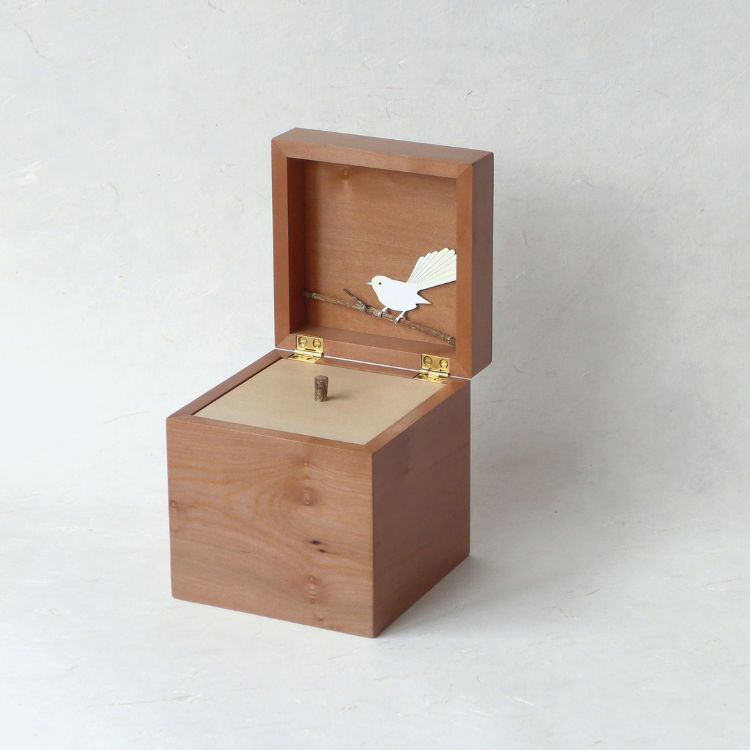
Photo by Linda Fredheim
Gay Hawkes
Gay Hawkes (1942–2025) long forged her own path - a maker whose work speaks with wit, defiance and care. Her sculptural furniture explores political and environmental themes through a resourceful “make-do” sensibility that values repair, reuse and the handmade.
Originally from Burnie, she taught abroad before returning to Hobart to study at the Tasmanian School of Art’s Centre for Furniture Design, developing a practice that embraced imperfection and immediacy, working with found materials in a deeply responsive, narrative way.
From her boat-shed studio, where she lived for many years, Hawkes established the Dunalley Children’s Chair Factory, teaching children her unique approach to art and making.
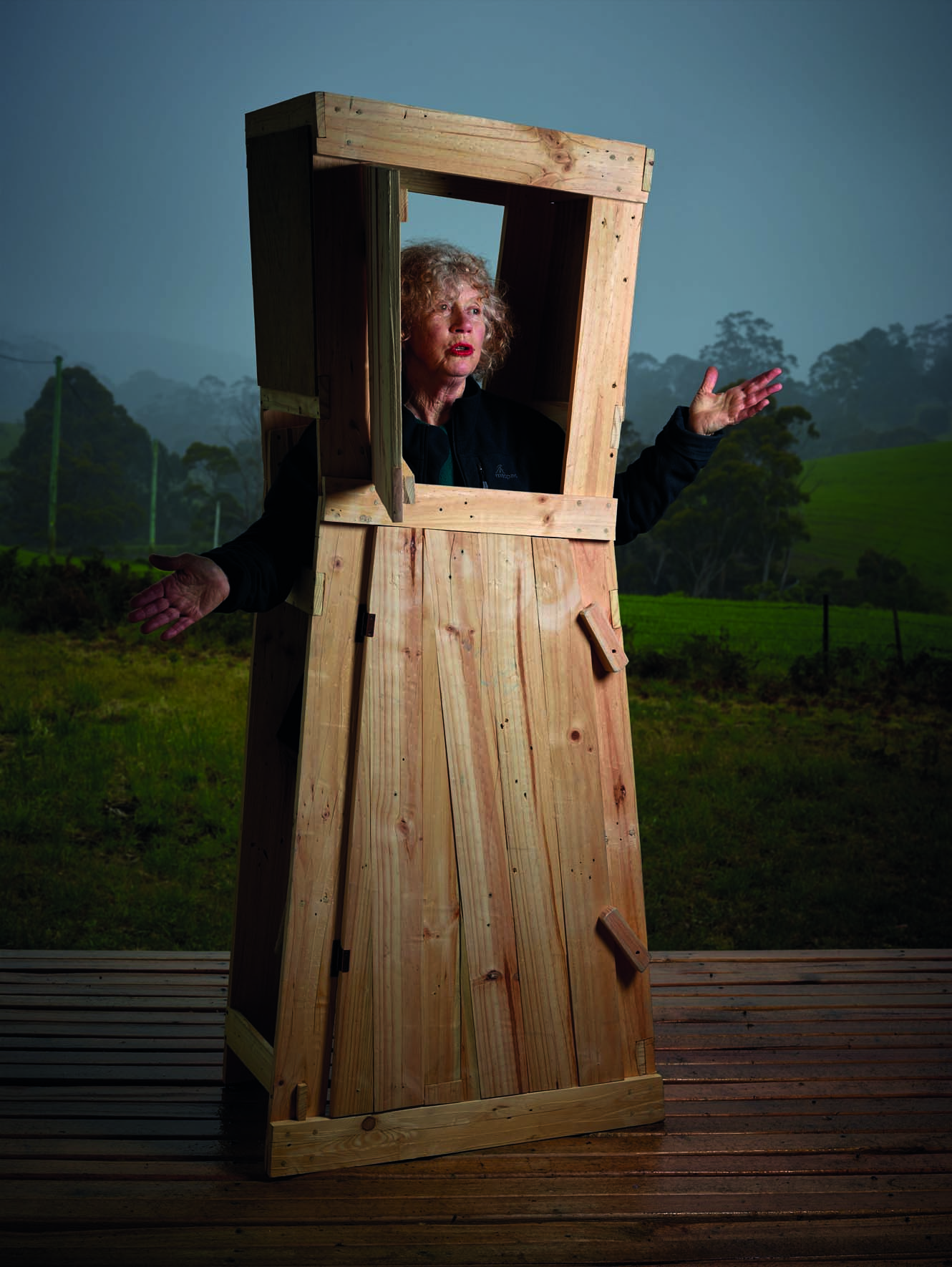
Photo by Peter Whyte
Portrait of Cape Barren Island
This chair reflects Gay’s lifelong love of the seaside and her narrative approach to working with timber and found materials.
Gay spent time on Cape Barren Island, making art and teaching children her approach to creating bush furniture from the materials around her.
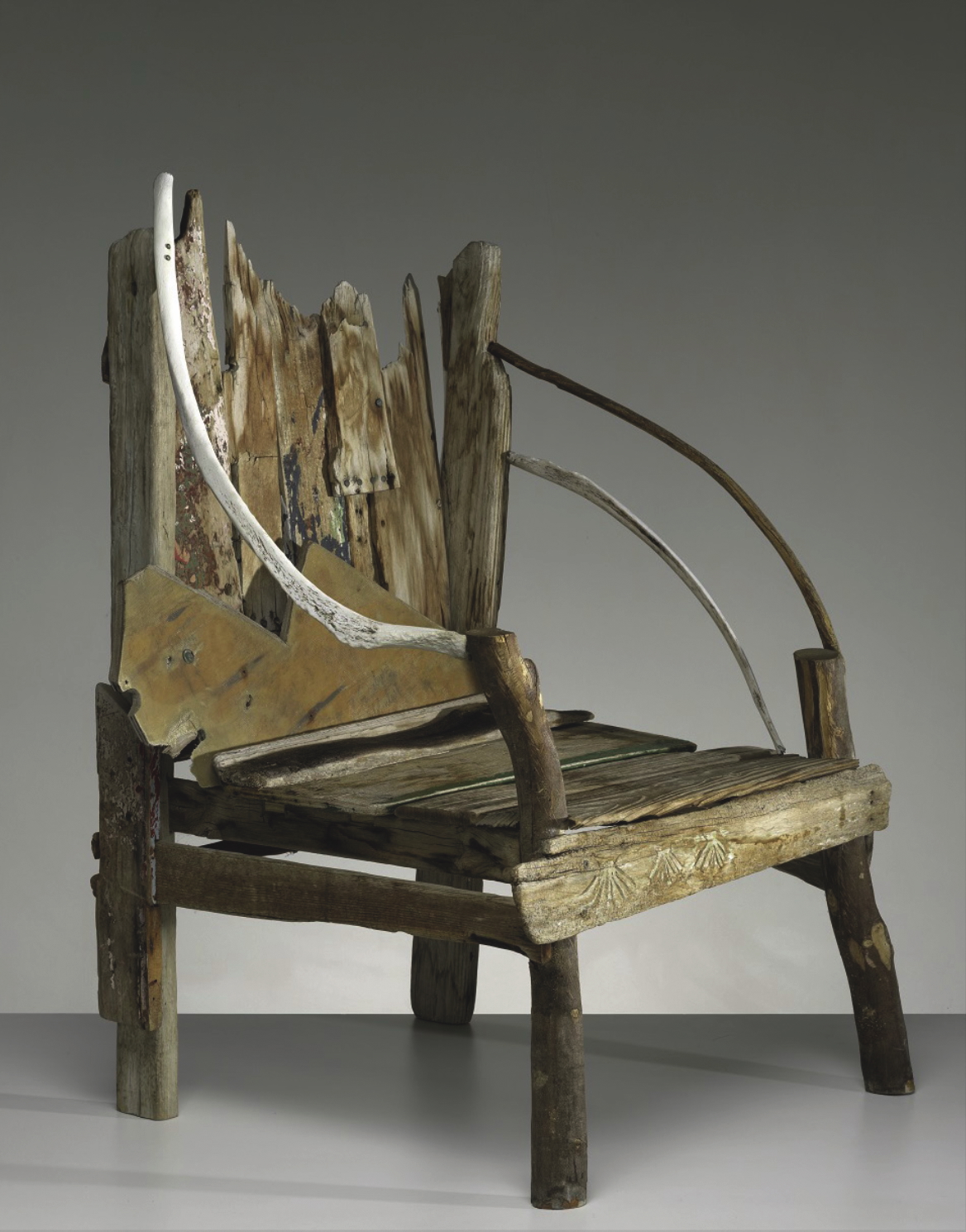
Chair on loan from Tasmanian Museum and Art Gallery, donated through the Australian Government’s Cultural Gifts Program by Patricia Cleveland. Image courtesy TMAG.
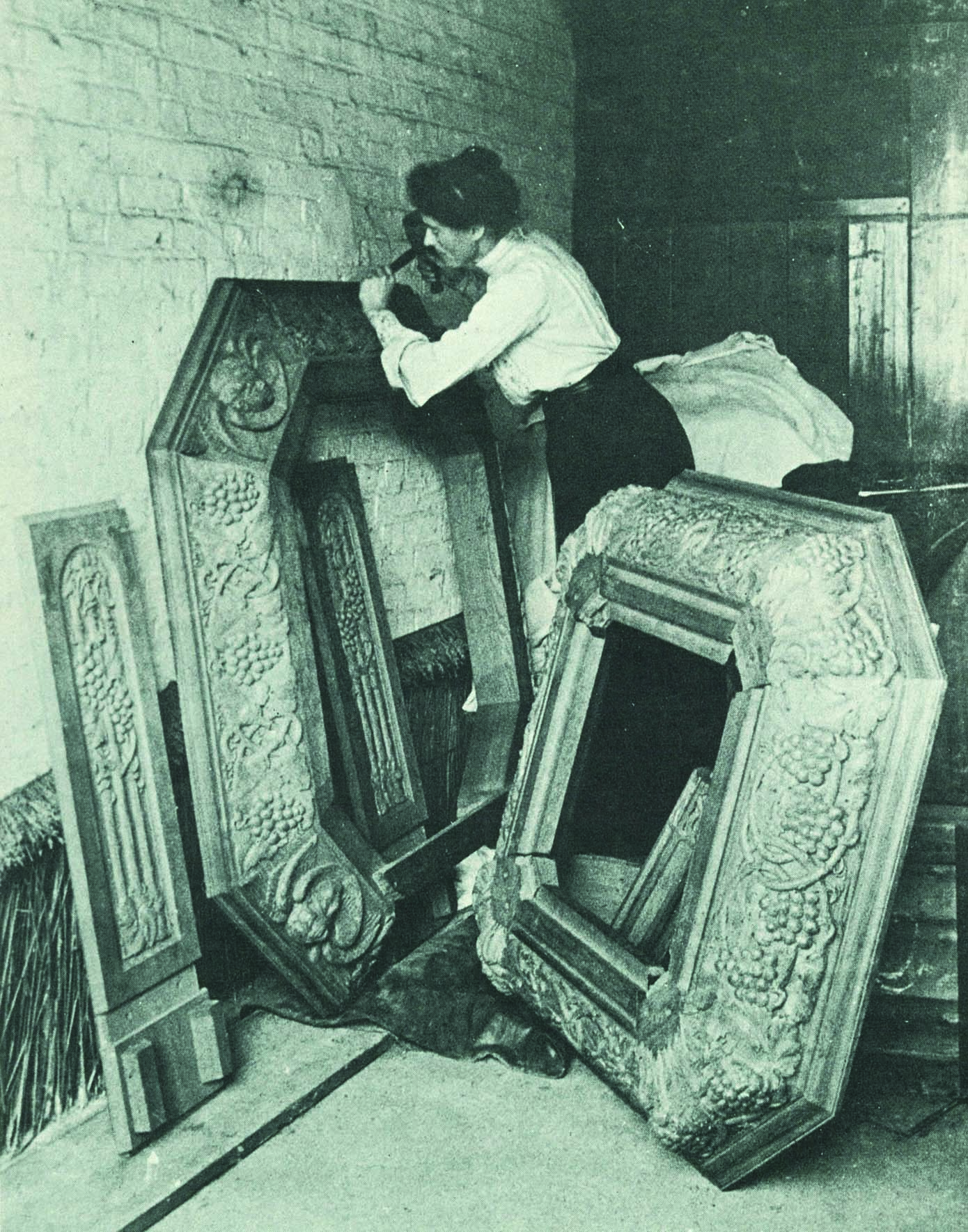
Ellen Nora (Nellie) Payne
Ellen Nora Payne’s (1865-1962) timber carving helped establish Tasmania’s reputation for craftsmanship and design. Born in Westbury, she trained in London at Goldsmiths School of Art before returning to create a prolific body of work spanning furniture, memorials and ecclesiastical commissions.
Her carving combined patience and precision with bold, sculptural rhythm, defining her many civic and church commissions of the time. Her 1939 coat of arms for the Tasmanian Parliament remains a touchstone of the state’s design heritage, as do her abundant carvings for St Andrew’s Church in Westbury.
Nellie stands as an origin point whose mastery of timber opened pathways for generations to follow.
Chair: In Memorian to Alice Shepherd White
This chair is typical of Nellie’s work - finely balanced between structure and ornament, its disciplined elegance reflecting both her Arts and Crafts training and a distinctly Tasmanian material integrity.
It is also characteristic of her practice of dedicating works to other women.
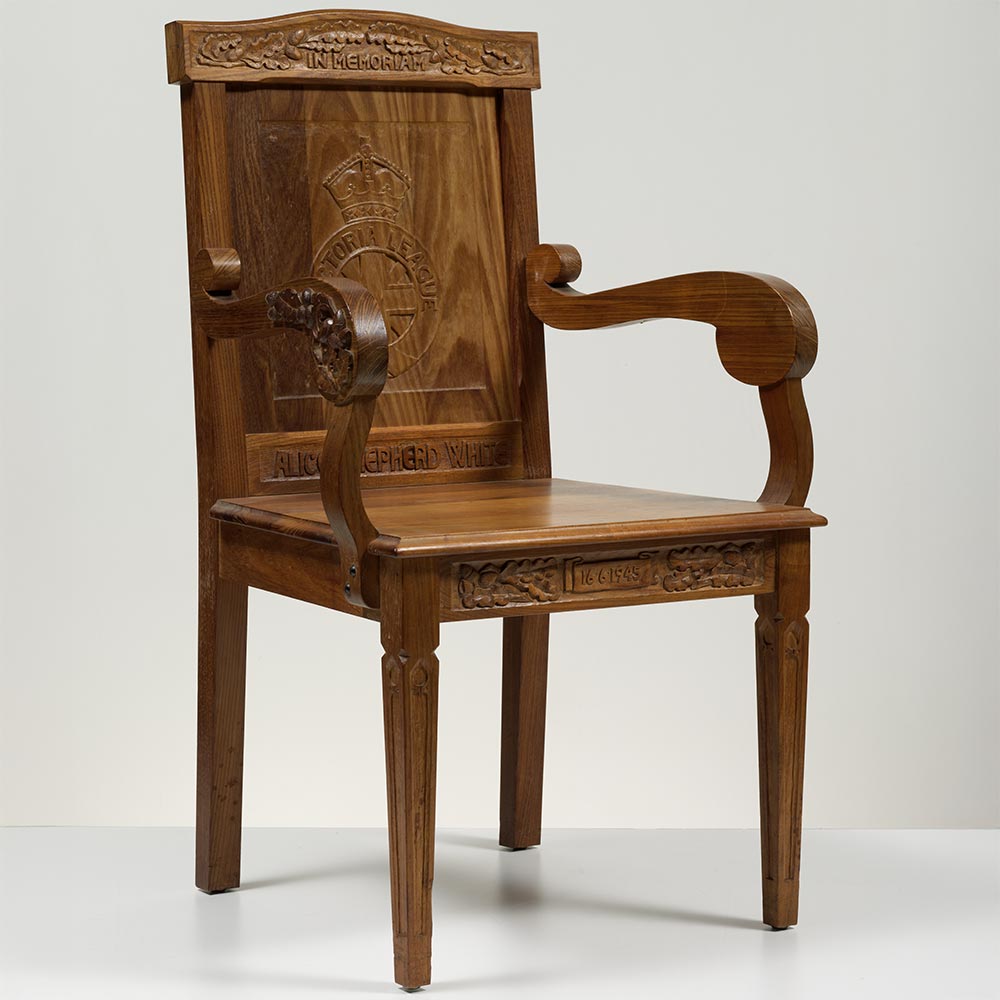
Chair on loan from the Tasmanian Museum and Art Gallery (TMAG) State Collection, gifted by the Victoria League. Photo courtesy TMAG.
Linda van Niekerk
After a successful business career, Linda switched her attention firstly to a degree in psychology and then to a long-time passion with jewellery. Born in South Africa, she relocated from Sydney to the beautiful Huon Valley in Tasmania’s south in 2005.
Thinking of herself as a conceiver of wearable sculpture rather than a jeweller, Linda enlisted the help of a private tutor to teach her technical skills, which would allow her to follow her own, sometimes unorthodox, approach to design. Her work is bold, visually striking and deceptively simple. Her desire is to create elegant sculptural forms that do not conform to the dictates of the market place or current fashion.
More of Linda's work can be found here:
https://lindavanniekerk.com
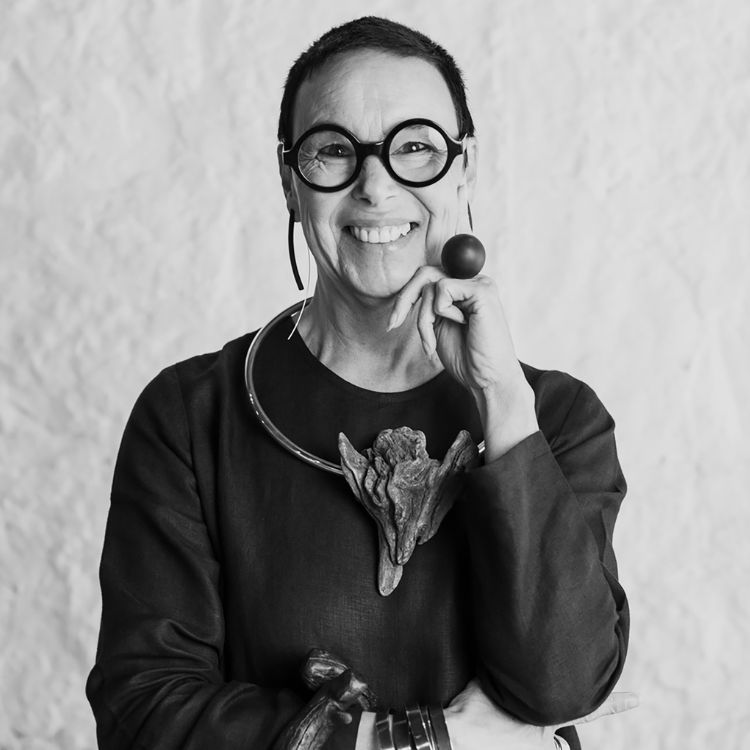
Photo by Melanie Kate Creative, courtesy of Handmark Gallery
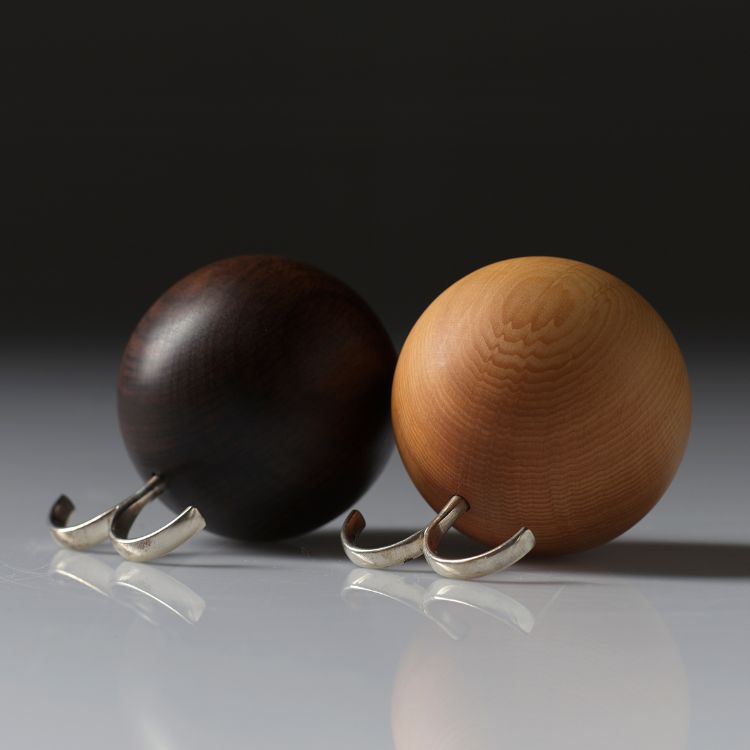
Photo by Peter Whyte
Forest Rings
The Forest Dark and Forest Light series of rings are designed to showcase the beauty of two of Tasmania’s iconic timbers. The base of the ring, which goes around two fingers, ensures that it feels secure and comfortable to the wearer while not distracting from the timber sphere. The effect is that the timber sphere appears to simply float on the wearer’s hand.
Forest Dark: Tiger Myrtle, sterling silver
Forest Light: Huon Pine, sterling silver
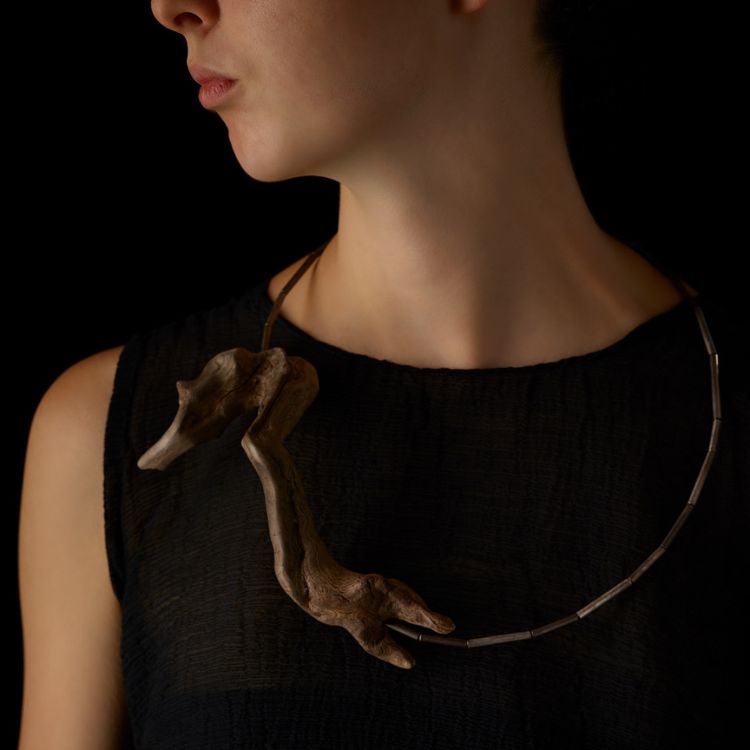
Photo by Peter Whyte
Wilderness Diftwood
My Tasmanian Wilderness driftwood works celebrate the beauty, evolution, and survival of one of nature’s most cherished elements, wood. This small selection of pieces each tells a unique story. From the gentle movement underwater to the raging rivers of time, each treasured piece of driftwood finds its way from the depths of the Tasmanian wilderness to be collected and crafted into works that showcase aged beauty.
"The driftwood in my work is gathered from inland waters, where it has been washed down from the World Heritage Wilderness forests. Calling it Wilderness Driftwood and creating simple, unique pieces where the driftwood is the hero is my modest tribute to the precious resource of Tasmania’s wilderness." - Linda
Sea Dragon Adrift
Tasmanian wilderness driftwood, oxidised sterling silver and nylon
Flight Adrift
Tasmanian wilderness driftwood, sterling silver and nylon
Eagle Adrift Torque
Tasmanian wilderness driftwood and sterling silver
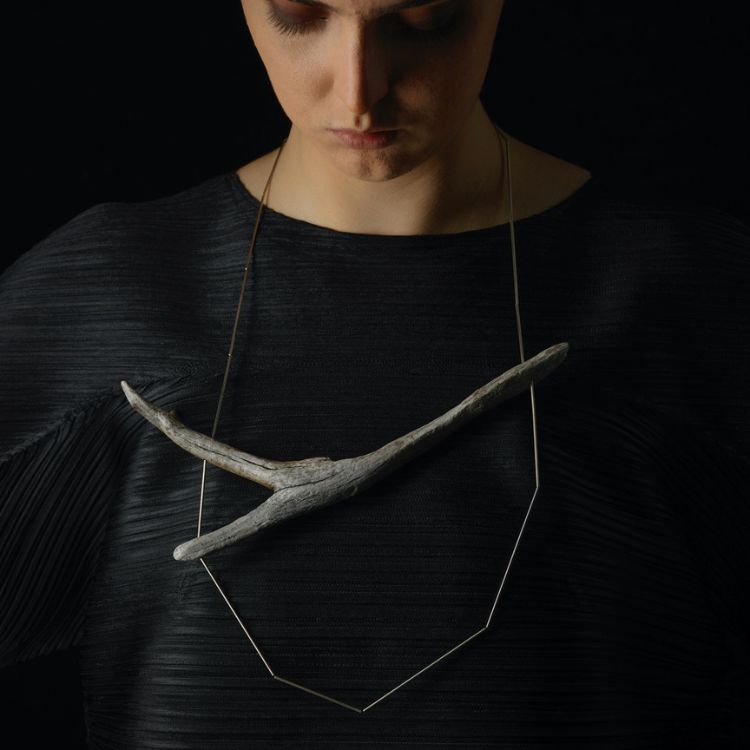
Photo by Peter Whyte
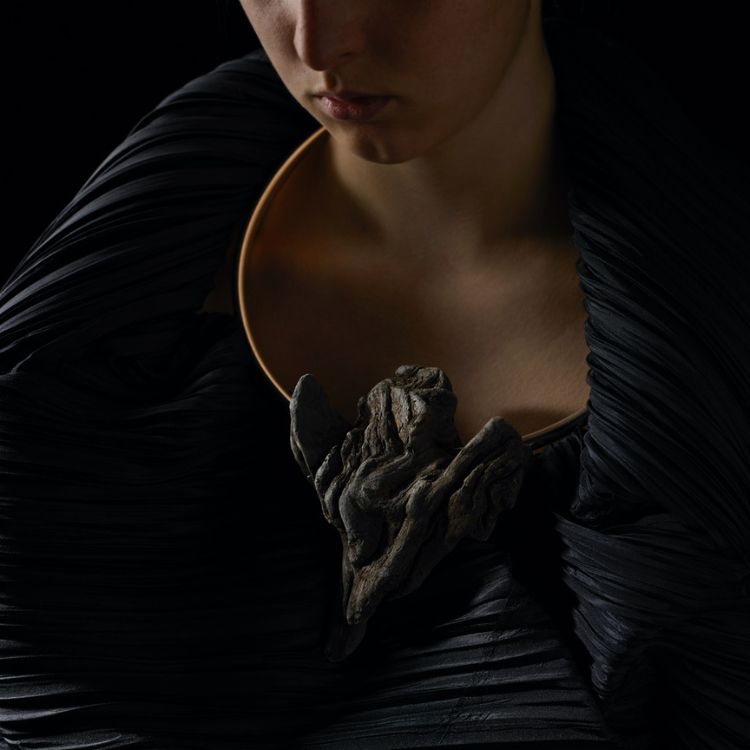
Photo by Peter Whyte
With thanks to our Sponsors
Heartwood – Tasmanian Women in Timber, and the acquisition of new work into the Design Tasmania Wood Collection, has been supported by Creative Australia through its Plus1 matched-funding program, with partnering support from the WD Booth Charitable Trust and Launceston Distillery. We also thank the Tasmanian Museum of Art Gallery and Clarence Council’s Clarence Prize Collection at Rosny Farm for assisting with loans for this exhibition.